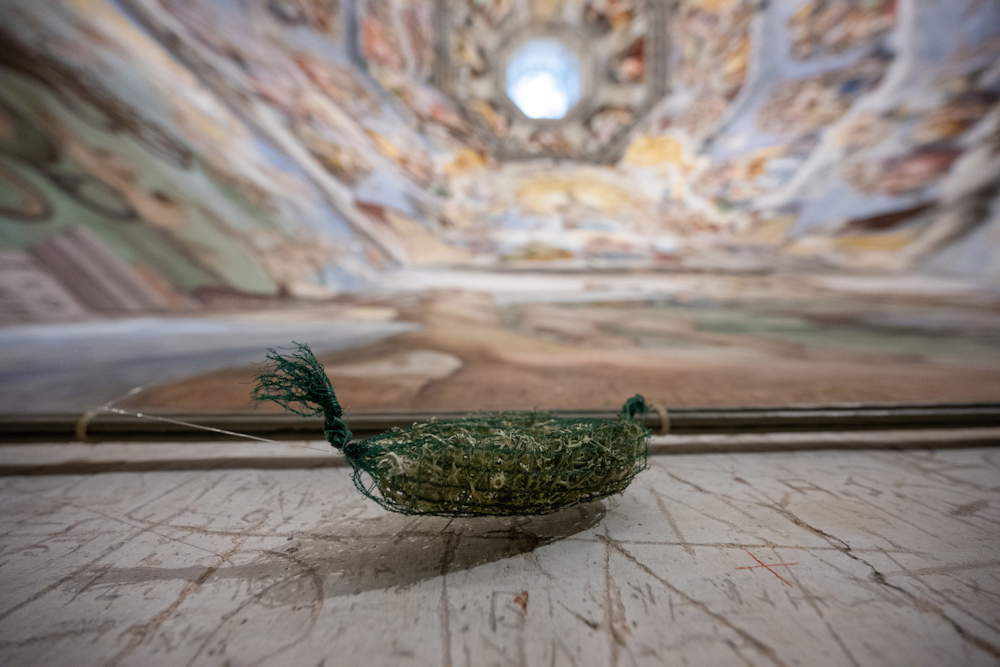The air inside Florence Cathedral will be biomonitored for the first time. Indoor air carries atmospheric particulate matter, also known as fine dust, and microorganisms from outside. For this reason, investigations will be carried out in parallel on two fronts: on the one hand, biomonitoring of atmospheric particulate matter will be carried out, and on the other, identification and quantification of microorganisms present in the air but also on the surfaces of different materials such as marble, stone, brick, plaster, and wood. The biomonitoring will be carried out through a project of theOpera di Santa Maria del Fiore with the National Institute of Geophysics and Volcanology, the University of Florence, the University of Siena and the Accademia Nazionale dei Lincei.
Biomonitoring of atmospheric particulate matter will be carried out using lichens that will be placed at various locations in the Cathedral, Brunelleschi’s Dome and in Santa Reparata for about three months. In the Dome, lichens have been placed on the three levels of the galleries, at 32 meters and 50 meters in height, and at the base of the frescoes, assuming that airflow can carry particulate matter and microorganisms from outside, through the doors, to the apex of the dome. Other lichens were placed inside Santa Reparata, to delineate the characteristics of particulate matter emitted at natural or forced air exchange systems. Still others were placed outside the facade of the Cathedral and the Cage of Crickets, to identify the characteristics of atmospheric particulate matter entering the monument. Analyses on the atmospheric particulate matter bioaccumulated by the lichens will allow the qualitative and quantitative determination, using chemical and magnetic methods, of the possible presence of pollutant metals inside Florence Cathedral, discerning their emissive sources. The data obtained from the microbiological analysis will then give useful information to identify potentially harmful species not only for the artistic heritage but also for human health.
For the microbiological part, microorganisms will be collected by theUniversity of Florence, in the same places where lichens are placed, directly on plates with nutrient media for fungi and bacteria for the purpose of their cultivation, and on microbiological filters for the purpose of total DNA extraction for metagenomic analysis.
“We are constantly working with universities and other institutes,” said Luca Bagnoli, president of the Opera di Santa Maria del Fiore, “on research and experiments aimed at the knowledge and conservation of our heritage. This research, in particular, will be able to be an indispensable complement to the monitoring and maintenance activities that we constantly carry out paying attention to the latest technologies and discoveries.”
“The use of lichens has a long tradition in biomonitoring and is related to their effectiveness in the retention of airborne components,” explained Aldo Winkler, physicist at the National Institute of Geophysics and Volcanology. “In the field of Cultural Heritage, we have used this multidisciplinary method, to date, at the Peggy Guggenheim Collection in Venice, in the loggias frescoed by Raphael in the Villa Farnesina and on the Palatine Hill of the Colosseum Archaeological Park in Rome, and in the Museums of National History and Fine Arts in Buenos Aires, with the aim of controlling, with non-invasive and biological methods, the diffusion of pollutant dust within cultural heritage assets placed in highly anthropized contexts.”
 |
| For the first time, air in Florence Cathedral will be biomonitored using lichens |
Warning: the translation into English of the original Italian article was created using automatic tools. We undertake to review all articles, but we do not guarantee the total absence of inaccuracies in the translation due to the program. You can find the original by clicking on the ITA button. If you find any mistake,please contact us.